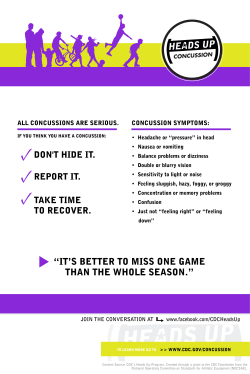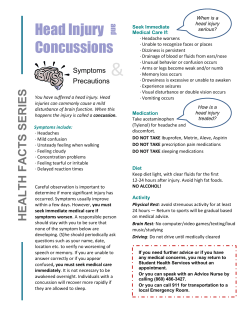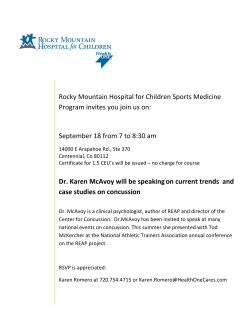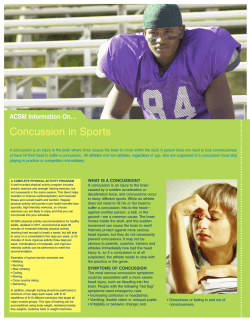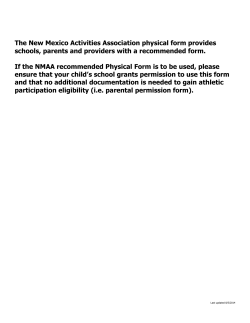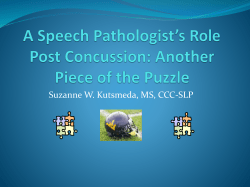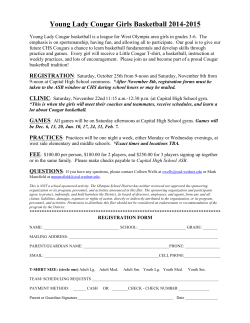
NFL to Friday Night Lights_Youth Sports Concussion
NFL to Friday Night Lights...Tackling Concussion Litigation Presented to: NJRPA Conference Presented by: Jon Cross, Esquire Marshall Dennehey Warner Coleman & Goggin 2000 Market Street, Suite 2300Philadelphia, PA 19103 P: (215) 575‐2750 E: jecross@mdwcg.com March 2015 www.marshalldennehey.com 1 This brochure was prepared by Marshall Dennehey Warner Coleman & Goggin to provide information of interest to our readers. This publication is not intended to provide legal advice for a specific situation or to create an attorney‐client relationship. We would be pleased to provide such legal assistance as you require on these and other subjects when called upon. ATTORNEY ADVERTISING pursuant to New York RPC 7.1 Copyright © 2015 Marshall Dennehey Warner Coleman & Goggin, all rights reserved. No part of this publication may be reprinted without the express written permission of our firm. For reprints or inquiries, contact tamontemuro@mdwcg.com. i Concussions ______________________________________________ True or False: To suffer a concussion, you need to be knocked out? (False) Helmets can fully protect one from a concussion? (False) Concussions show up on a CAT scan? (False) Litigation about concussions in sports is meritless? (False) What Is a Concussion? Disturbance in brain function Type of traumatic brain injury (TBI) Caused by a blow to the head or body, a fall, or another injury that jars or shakes the brain inside the skull "Ding" or "getting your bell rung" may be a concussion What Happens to the Brain? 1 Recognizing a Concussion A concussion rarely results in an athlete being "knocked out" We cannot see a concussion Signs and symptoms can show up right after the injury, days, or weeks after the injury Symptoms Noticed by Coach/Parent Dazed or stunned Confused about assignment or position Forgets an instruction Unsure of game, score, or opponent Poor balance, coordination, and concentration Answers questions slowly or inaccurately Loses consciousness (even briefly) Shows mood, behavior, or personality changes Unable to recall events prior to or after the hit Symptoms Noticed by Athlete Headache Nausea or vomiting Balance problems or dizziness Double or blurry vision Sensitivity to light or noise Feels sluggish Concentration or memory problems Confusion Feeling down Problems of Returning Too Soon Prolonged post‐concussion symptoms Vulnerable to second impact syndrome Second impact syndrome can lead to severe brain injury or even death in extreme cases Potential Long‐Term Effects Headache Fatigue Sensitivity to noise or light Memory challenges Difficulty sleeping Dizziness Repeated Traumatic Brain Injury May Lead to… Shortened life expectancy Death Suicide 2 Dementia Alzheimer's disease Parkinson's disease Amyotrophic lateral sclerosis (ALS) Brain bleeds Drug abuse Endless debt Broken lives Lawsuits Post Concussion Life‐Long Effects Scott Stevens crushing Eric Lindros (Eastern Conference Finals 2000) Lindros's injury prevented him from playing the following season, and he continues to suffer post‐concussion symptoms Neurodegenerative Diagnosis Muhammad Ali – diagnosed with Parkinson's Disease at age 42 Lou Gehrig died from ALS at age 37 o While playing baseball he suffered at least 4 concussions o Played both high school and college football o Researchers have since questioned whether his disease was actually the result of repetitive head trauma 3 The Fallout ______________________________________________ Class Action Concussion Lawsuit Against the NFL Failed to warn of the risks of head injuries Subjected players to repetitive head trauma Failed to properly treat the injuries Failed to warn of the effects of concussions NFL Settlement July 7, 2014 Eastern District of Pennsylvania granted preliminary approval At least $765 million over 65 years to ex‐players diagnosed with Alzheimer's disease, dementia, and other serious brain injuries Pay up to $5 million to those with the most serious neurological impairments Pay $4 million to families of former players who died from CTE before July 7, 2014 Benefits of Proposed Settlement Baseline medical exams for retired players Monetary awards for diagnoses of ALS, Alzheimer's, Parkinson's, dementia, and certain cases of CTE diagnosed after death Education programs and initiatives related to football safety All valid claims will be paid in full for 65 years Do not have to prove players' injuries were caused by playing NFL football to receive money from the settlement November 19, 2014 ‐ Court Fairness Hearing Most of the 20,000 former players backed the deal Some former players argued proposed settlement is unreasonable, inadequate, unfair, or arbitrary The hearing was to determine whether the court will approve the proposed settlement February 2, 2015 ‐ Approval Still Pending Judge Brody required that retired players who died of CTE after she granted preliminary approval will be covered Credit for players from World League and NFL Europe Testing of more players "regardless of funding limitations" stated in the agreement Other Examples: Estate of Junior Seau Lawsuit Hall of Fame player shot himself in the chest (2012) Suffered from CTE 4 Javon Belcher Estate vs. Kansas City Chiefs Killed his girlfriend Shot himself in front of Coach and GM Suffered from CTE Class Action Lawsuit Against the NCAA Claim for breach of contract and common law duties due to the manner the NCAA handled concussions and concussion‐related risks Proposed settlement July 2014: o Pay $70 million to create a medical monitoring fund to pay the expenses associated with diagnosing and monitoring head injuries o Policy changes to "return‐to‐play" guidelines o Provide $5 million in additional funds for concussion‐related research Soccer Players vs. FIFA Claims FIFA failed to enact the policies and rules needed to protect players (August 2014) Uruguay's Alvaro Pereira was one of five documented cases of concussion at the World Cup in Brazil in 2014 Christian et. al. vs. The NHL Claims NHL had knowledge and resources to better prevent head trauma, failed to properly warn players of the risks, and promoted violent play that led to their injuries (October 20, 2014) Baucham vs. USC and Former Coach Lane Kiffin Alleges negligence for forcing Baucham to continue to play while ill and failing to follow concussion guidelines, leaving Baucham with cardiopulmonary damage and brain injury (September 2014) Plevretes vs. LaSalle University In 2005, Preston Plevretes of LaSalle University was knocked unconscious and fell into a coma after a hit during a game He suffered a concussion several days before during practice $7.5 million settlement with the University LaSalle University no longer has a football team (related?) Source: Chicago Brain Injury Blog, November 30, 2009 College Coach Resignation Columbia football coach resigns amid controversy of abuses, including mishandling concussions (December 2014) 5 Baseball Is a Contact Sport Too Baseball Concussion University of Michigan Quarterback remains in game after suffering a hit that caused a concussion Michigan President Mark Schlissel "Despite having one of the finest levels of team medical expertise in the country, our system failed on Saturday. We did not get this right and for this I apologize to Shane, his family, his teammates, and the entire Michigan family." (September 30, 2014) 6 NFL Protocol ______________________________________________ NY Giants Concussion Spotter and Protocol Head‐injury spotter in an upper‐level booth Spotter is a seasoned athletic trainer paid for by the NFL Watching for big hits that may lead to head or neck injuries Access to video instant replay Viewing balance issues, shaking head after a hit, or adjusting helmet Communicates with the athletic trainers and doctors on the field Spotter alerts athletic trainer to remove player to be examined Team doctor conducts balance and cognitive skills testing Neurologist, hired by the league, assists in examination Doctor makes decision ‐ "Go or No Go" 7 The Statistics ______________________________________________ How Prevalent Is Traumatic Brain Injury in the U.S.? 2.5 million traumatic brain injuries in 2010 TBI Treated in the U.S. 280,000 52,000 Treated and Released from ER Hospitalized Die 2,200,000 75% of TBIs are concussions or minor head trauma Source: http://www.cdc.gov/traumaticbraininjury/get_the_facts.htm Youth Sports Injury Statistics At least 2.4 million emergency department visits, hospitalizations, or deaths were related to a traumatic brain injury in 2009 Source: Centers for Disease Control and Prevention Direct and indirect costs (such as lost wages and productivity) of traumatic brain injury totaled an estimated $76.5 billion per year in the U.S. Source: S. Adams – Bloomberg News 2013 Organized sports account for some 3.5 million youth injuries each year Source: According to the Boston Children's Hospital 1.24 million children were seen in Emergency Rooms for sports injuries in 2013 – averages 3,397 a day Source: Safe Kids Worldwide 8 Youth Sports Injury Statistics 2012 Emergency Room Data by Sport U19 Football Basketball Soccer Baseball Softball Volleyball Wrestling Cheerleading Gymnastics Track & Field Number of Injuries (2012) 394,350 389,610 172,470 119,810 58,210 43,190 40,750 37,770 28,300 24,910 *Note – ice hockey has a high percentage of injuries/concussions per player, however, it is not listed due to the fact the amount of participants in the U.S. is smaller than other sports Source: Safe Kids Worldwide How Many Concussions Occur Each Year in Youth Sports? 1.6 – 3.8 MILLION Source: Centers for Disease Control & Prevention Hits to the Head Youth Football Player One player can expect to take 2,235 hits to the head in one season Source: Journal of Athletic Training 2009 Amateur Football Concussions 10% of college players sustain concussions in any given season 20% of high school players sustain concussions in any given season o Almost 9% of all injuries reported occur in high school sports o High school athletes are three times more likely to sustain a second concussion Source: Centers for Disease Control & Prevention Soccer Injuries Due to Head Balls 30% of concussions are caused by attempting to head the ball due to weak necks of kids under 15 or jumping head‐to‐head Source: Sports Legacy Institute 9 Concussion Risk Management and Prevention ______________________________________________ Failure of Coaches/Administrators Illinois High School State Wrestling Championship Potential Claims in Concussion Litigation Adequate supervision Instruction and training about safe techniques Warn of the inherent risks of the sport Explain the rules of the game Match players based on size, age, and experience Safety equipment that meets existing standards Inspect the facility and the safety equipment Facility suitable for the activity Notice a concussion and remove player from game Post‐injury evaluation by medical professional Adhere to proper return to play protocols Mercier v. Westminster School and Greenwich Academy (2013) Female basketball player for Westminster injured Advised her coach – dizzy, blurry eyes, and needed to sit down Greenwich did not have a trainer present to examine her After five minutes, coach put her back in the game Struck in the head a second time Court found in favor of defendants, recognizing coaching decisions involve split‐second, subjective decisions Ridolfi vs. Begano (Colorado 2010) The Facts: o High school football player injured around 7:50 a.m. at practice o Dizzy, vomiting, and suffering from severe headaches o Coaches had him continue to practice o Complained about his injuries, began stumbling and slurring his speech o Coaches did not bring him to the hospital until around 3:30 p.m. o Suffered permanent brain damage as a result of a concussion The Lawsuit: o Coaches were found negligent for returning him to practice despite concussion symptoms o The total verdict against coaches $11.5 million o Coaches did not pay due to immunity as government employees 10 o Jury also found helmet maker liable for design defect and failure to warn in the amount of $3.1 million Maddie Urban v. Downingtown East High School (2014) Female soccer player injured her head Coach failed to remove her from the game She continued to head the ball and collided with additional players Symptoms persisted for a year Pending lawsuit against the school and coach for negligence Now playing with a different coach and team after a doctor at CHOP said to heal, she needed to play Bukal v. Illinois HS Association (2014) Former high school quarterback at Notre Dame Prep in 2000s Suffered multiple concussions Memory loss and migraines related to the injuries Alleges IHSA failed to protect players from concussion damages Lawsuit demands medical personnel present at all games, on‐call for all practices, and obligatory computer‐based concussion screening Due to expenses, could lawsuit be the end of high school football? Fewer than half of the state's high schools have athletic trainers, let alone contracted doctors, and cost of insurance will rise Girl Scout v. Camp Archibald (Philadelphia, PA) Girl scout fell off a rock formation Suffered traumatic brain injury Claimed she was unsupervised Settlement $2.8 million (2015) Estate Chernach v. Pop Warner (Wisconsin 2015) Committed suicide at age 25, in 2012 Diagnosed with CTE The lawsuit alleges that Pop Warner failed to: o Warn players and train coaches o Require the safest helmets and teach how to wear properly o Limit the amount of hitting in practice o Follow concussion protocols; and o Knew or should have known that tackle football was dangerous and exposed children to head injuries, which could result in CTE (Strict Liability) o Claiming at least $5 million in punitive damages o Played high school football, wrestler, and track team pole vaulter – key defense facts 11 Potential National Effect of Litigation ______________________________________________ Who will insure youth football if strict liability applied? Will insurance companies increase their premiums to offset legal risks? Will insurance be affordable to programs? Sports Concussion Assessment Tools (SCAT) A. Following a concussion, medical professionals will evaluate players daily before allowing a return to play B. Assessment tests include: a. Graded system checklist b. Balance assessment c. Cognitive testing (mini‐mental status) C. In lawsuits, testing will be scrutinized by lawyers on the treatment and the timing of return to play Graded System Checklist Headache 0 1 2 3 4 5 6 Don’t feel right 0 1 2 3 4 5 6 Difficulty concentrating 0 1 2 3 4 5 6 Pressure in the head 0 1 2 3 4 5 6 Difficulty remembering 0 1 2 3 4 5 6 Neck pain 0 1 2 3 4 5 6 Fatigue or low energy 0 1 2 3 4 5 6 Nausea or vomiting 0 1 2 3 4 5 6 Confusion 0 1 2 3 4 5 6 Dizziness 0 1 2 3 4 5 6 Drowsiness 0 1 2 3 4 5 6 Blurred vision 0 1 2 3 4 5 6 Trouble falling asleep 0 1 2 3 4 5 6 Balance problems 0 1 2 3 4 5 6 More emotional 0 1 2 3 4 5 6 Sensitivity to light 0 1 2 3 4 5 6 Irritability 0 1 2 3 4 5 6 Sensitivity to noise 0 1 2 3 4 5 6 Sadness 0 1 2 3 4 5 6 Feeling slowed down 0 1 2 3 4 5 6 *Athlete should not return to competition until all scores are zeros Balance Assessment – Romberg's Test 1. Single leg balance (eyes open) 2. Single leg balance (eyes closed) 3. Tandem stance (eyes open) 4. Tandem stance (eyes closed) 5. Heel‐to‐toe walking (eyes open) 6. Heel‐to‐toe walking (eyes closed) 12 Cognitive Testing (Mini‐Mental Status Exam) Athlete: ___________________ Maximum Score Athlete Score 5 5 3 Date: 2 3 Questions "Take a piece of paper in your right hand, fold in half with both hands, and put it back on the desk with your left hand." Please read this and do what it says, "Close your eyes." 3 1 Make up a sentence about anything. The sentence must have a noun and a verb. Please name the three things I told you earlier. Please copy this picture: 30 TOTAL 1 The examiner names 3 unrelated objects. The athlete must repeat the list and commit it to memory. Count backwards from 100 by 3s or spell WORLD backwards Show the athlete two simple objects, such as a pen and a chair, and ask the athlete to name them. Repeat the phrase: "no ifs, ands, or buts. 1 What is the Year?, Season?, Date?, Day of the Week?, Month? Where are we now?, State?, Town?, City?, School?, Room? 5 1 13 Mitigating the Risk of Concussion…. What's Ahead? ______________________________________________ Improved Helmet Technology Rawlings S100 Pro Comp protects against pitches up to 100 mph o Designed per CBA covering 2012‐2016 Ice Hockey ‐ Cascade M11 helmet is a project spearheaded by Mark Messier o New technology to reduce the risk of concussion‐related injuries Riddell Speedflex helmet (2014) o Engineered to disperse energy and reduce the risk of trauma Hit Sensors/Trackers (2014) Used to detect number of hits to the helmet Relays information to a smartphone so the severity of an impact is known immediately Information is stored on a server for later reference and used if needed Vector Mouth Guards University of Kansas football experiment (spring 2015) Digital alert if a hit is severe enough to lead to concussion Measures the impact a player's head takes during a collision Coaches Teaching Safe Techniques Heads Up Tackling Immediate Post‐Concussion Assessment and Cognitive Testing System (ImPACT) Establish a player's baseline conditions at the start of a season Neuropsychological testing of memory, attention, reaction time, visual‐motor speed, and other brain functions that are typically affected by concussion Implemented if the player sustains a concussion Neuropsychologist interprets the results of the exam It is the ONE tool to help with return‐to‐play decisions ImPACT is currently used at high schools, colleges, NFL, MLB, and NHL Medical Clearance/Return‐to‐Play Protocols Step 1: Completion of a full day of normal cognitive activities Step 2: Light aerobic exercise Step 3: Sport‐specific exercise: no head impact activities Step 4: Non‐contact training drills Step 5: Following medical clearance, participation in full practice Step 6: Return to play involving normal exertion or game activity 14 Youth Safety Sports Act In 2009, the state of Washington passed the first concussion sports law, the Zackery Lystedt Law Now all 50 states have passed a law relating to schools and handling sports‐related concussion issues New Jersey Youth Sports Concussion Safety Law (2010) 1. Head Injury Safety Training – for all coaches, athletic trainers, school nurses, and school/team physicians 2. Educational Fact Sheet – distributed annually to all student athletes and requires a signed acknowledgement from each parent/guardian and student athlete 3. Written Policy – concerning prevention/treatment 4. Removal from Play – immediate after head injury 5. Return‐to‐Play Protocols 6. Immunity from liability – school shall not be liable for injury or death due to acts of youth organization on school grounds if: a. Proof of insurance at minimum $50,000 per claim and b. A statement of compliance with the school's policies for the management of concussions and other head injuries Source: N.J. Stat § 18A:40‐41.1‐.5.; See also similar Pennsylvania Statute 24 P.S. § 5321 New Rules May Reduce Risk Sport Rules/Actions NFL Collective Bargaining Agreement – limits to "full hitting" practices NFL Moved kickoff from 35 to 30 yard line to reduce head collisions NFL Donates $45 million to USA Football Heads Up Tackling program to teach proper technique Football Penalty flag for leading with the helmet on tackles Football Penalty flag for touching the QB in the head Football Coaches are being asked to eliminate the unnecessary hard hitting and ramming of the helmets drills, modify certain drills, and minimize certain drills where there is hitting on the head USA Hockey Raised the age of the introduction to checking to 13 Soccer Emerging policy in some youth leagues of no head balls Baseball No running into the catcher – cannot block plate (MLB 2014) 15 About Your Presenter ______________________________________________ Jonathon E. Cross Associate Marshall Dennehey Warner Coleman & Goggin 2000 Market Street, Suite 2300 Philadelphia, PA 19103 (215) 575‐2750 (215) 575‐0856 ‐ Fax jecross@mdwcg.com As a former athlete and coach, Jon brings his unique experience to sports and recreation liability claims. He represents and defends sports and recreation owners, coaches and instructors, youth athletic organizations, golf clubs, professional athletes as well as athletic departments in school districts, colleges and universities. Jon is also experienced in defending clients in matters involving premises liability, automobile liability, product liability, insurance bad faith and trade secrets. The greater portion of Jon’s practice is providing legal counsel to professionals, including attorneys, accountants, insurance brokers, real estate brokers and financial advisors, in a wide range of matters including legal malpractice, accounting malpractice, wrongful use of civil process, abuse of process, negligence and breach of contract claims. Outside of his law practice, Jon serves on the Executive Board of the Richie Ashburn Foundation, which raises funds to provide over 19 free baseball camps and clinics yearly to children throughout the Philadelphia and suburban area. Furthermore, Jon works with the Foundation to raise funds to support blind and visually impaired children to play “beep” baseball. Formerly, Jon was the head baseball coach at the William Penn Charter School in Philadelphia, PA. Further, he coached for four seasons Division‐I level at the University of Pennsylvania. Prior to coaching at Penn, he coached for nine years at Germantown Academy. As a coach, he has organized and instructed at local and national baseball camps and clinics, and he owned his own winter and summer baseball camps. In addition, for eight years Jon was a member of the Board of Trustees at Germantown Academy and served as the chair of the sports/athletic committee. 16 OUR LOCATIONS PENNSYLVANIA NEW JERSEY FLORIDA 2000 Market Street, Suite 2300 Philadelphia, PA 19103 215.575.2600 • 215.575.0856 (Fax) Woodland Falls Corporate Park 200 Lake Drive East, Suite 300 Cherry Hill, NJ 08002 856.414.6000 • 856.414.6077 (Fax) 100 Northeast 3rd Avenue, Suite 1100 Fort Lauderdale, FL 33301 954.847.4920 • 954.627.6640 (Fax) 4905 West Tilghman Street, Suite 300 Allentown, PA 18104 484.895.2300 • 484.895.2303 (Fax) 100 Corporate Center Drive, Suite 201 Camp Hill, PA 17011 717.651.3500 • 717.651.3707 (Fax) 10 N. Main Street, 2nd Floor Doylestown, PA 18901 267.880.2020 • 215.348.5439 (Fax) 425 Eagle Rock Avenue, Suite 302 Roseland, NJ 07068 973.618.4100 • 973.618.0685 (Fax) DELAWARE 200 W. Forsyth Street, Suite 1400 Jacksonville, FL 32202 904.358.4200 • 904.355.0019 (Fax) Landmark Center One 315 E. Robinson Street, Suite 550 Orlando, FL 32801 407.420.4380 • 407.839.3008 (Fax) Nemours Building 1007 N. Orange Street, Suite 600 Wilmington, DE 19801 302.552.4300 • 302.552.4340 (Fax) 201 E. Kennedy Boulevard, Suite 1100 Tampa, FL 33602 813.898.1800 • 813.221.5026 (Fax) OHIO NEW YORK 620 Freedom Business Center, Suite 300 King of Prussia, PA 19406 610.354.8250 • 610.354.8299 (Fax) 312 Elm Street, Suite 1850 Cincinnati, OH 45202 513.372.6800 • 513.372.6801 (Fax) 105 Maxess Road, Suite 303 Melville, NY 11747 631.232.6130 • 631.232.6184 (Fax) U.S. Steel Tower, Suite 2900 600 Grant Street Pittsburgh, PA 15219 412.803.1140 • 412.803.1188 (Fax) 127 Public Square, Suite 3510 Cleveland, OH 44114-1291 216.912.3800 • 216.344.9006 (Fax) Wall Street Plaza 88 Pine Street, 21st Floor New York, NY 10005 212.376.6400 • 212.376.6490 (Fax) 717 State Street, Suite 701 Erie, PA 16501 814.480.7800 • 814.455.3603 (Fax) P.O. Box 3118 Scranton, PA 18505 570.496.4600 • 570.496.0567 (Fax) 800 Westchester Avenue, Suite C-700 Rye Brook, NY 10573 914.977.7300 • 914.977.7301 (Fax) A DEFENSE LITIGATION LAW FIRM www.marshalldennehey.com A DEFENSE LITIGATION L AW FIRM I PA NJ DE OH FL NY I www.marshalldennehey.com
© Copyright 2025
